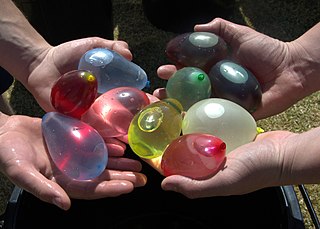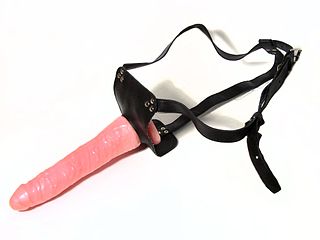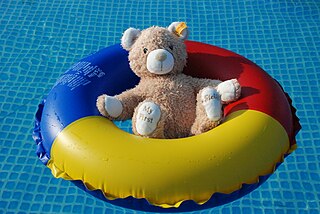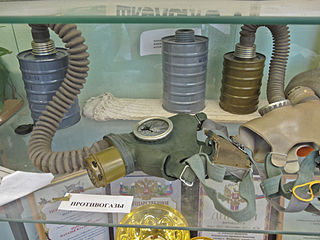
Snorkeling is the practice of swimming face down on or through a body of water while breathing the ambient air through a shaped tube called a snorkel, usually with swimming goggles or a diving mask, and swimfins. In cooler waters, a wetsuit may also be worn. The snorkel may be an independent item or integrated with the mask. The use of this equipment allows the snorkeler to observe the underwater environment for extended periods with relatively little effort, and to breathe while face-down at the surface.

A wetsuit is a garment worn to provide thermal protection while wet. It is usually made of foamed neoprene, and is worn by surfers, divers, windsurfers, canoeists, and others engaged in water sports and other activities in or on water. Its purpose is to provide thermal insulation and protection from abrasion, ultraviolet exposure, and stings from marine organisms. It also contributes extra buoyancy. The insulation properties of neoprene foam depend mainly on bubbles of gas enclosed within the material, which reduce its ability to conduct heat. The bubbles also give the wetsuit a low density, providing buoyancy in water.

A water balloon or water bomb is a balloon, often made of latex rubber, filled with water. Water balloons are used in a summer pastime of cooling off through water balloon fights. Water balloons are also popular for celebrations, including celebrating Holi and Carnival in India, Nepal, and several other countries.

A spraydeck is a flexible waterproof cover for a boat with holes for the passengers' waists. Spraydecks are used to prevent water from entering the boat while allowing passengers to paddle or row.

The bottom bracket on a bicycle connects the crankset (chainset) to the bicycle and allows the crankset to rotate freely. It contains a spindle to which the crankset attaches, and the bearings that allow the spindle and crankset to rotate. The chainrings and pedals attach to the cranks. Bottom bracket bearings fit inside the bottom bracket shell, which connects the seat tube, down tube and chain stays as part of the bicycle frame.

A speargun is a ranged underwater fishing device designed to launch a tethered spear or harpoon to impale fish or other marine animals and targets. Spearguns are used in sport fishing and underwater target shooting. The two basic types are pneumatic and elastic. Spear types come in a number of varieties including threaded, break-away and lined. Floats and buoys are common accessories when targeting larger fish.

A full-face diving mask is a type of diving mask that seals the whole of the diver's face from the water and contains a mouthpiece, demand valve or constant flow gas supply that provides the diver with breathing gas. The full face mask has several functions: it lets the diver see clearly underwater, it provides the diver's face with some protection from cold and polluted water and from stings, such as from jellyfish or coral. It increases breathing security and provides a space for equipment that lets the diver communicate with the surface support team.

Goggles, or safety glasses, are forms of protective eyewear that usually enclose or protect the area surrounding the eye in order to prevent particulates, water or chemicals from striking the eyes. They are used in chemistry laboratories and in woodworking. They are often used in snow sports as well, and in swimming. Goggles are often worn when using power tools such as drills or chainsaws to prevent flying particles from damaging the eyes. Many types of goggles are available as prescription goggles for those with vision problems.

An assistive cane is a walking stick used as a crutch or mobility aid. A cane can help redistribute weight from a lower leg that is weak or painful, improve stability by increasing the base of support, and provide tactile information about the ground to improve balance. In the US, ten percent of adults older than 65 years use a cane, and 4.6 percent use walkers.

The Siebe Gorman Salvus is a light oxygen rebreather for industrial use or in shallow diving. Its duration on a filling is 30 to 40 minutes. It was very common in Britain during World War II and for a long time afterwards. Underwater the Salvus is very compact and can be used where a diver with a bigger breathing set cannot get in, such as inside cockpits of ditched aircraft. It was made by Siebe Gorman & Company, LTD in London, England. It was designed in the early 1900s.
Due to the nature of triathlons as a race consisting of multiple sports many pieces of technical equipment have been borrowed from other sports, or developed specifically in an effort to race faster and improve a competitors safety.

In rhythmic gymnastics, a gymnastics ribbon is an apparatus composed of a handle, a ribbon, and attachment, that is used during a floor performance.

A strap-on dildo is a dildo designed to be worn, usually with a harness, during sexual activity. Harnesses and dildos are made in a wide variety of styles, with variations in how the harness fits the wearer, how the dildo attaches to the harness, as well as various features intended to facilitate stimulation of the wearer or a sexual partner. Strap-on dildos are most frequently used by lesbian women, but can be used by people of any gender or sexuality.

A swim ring is a toroid-shaped inflatable water toy.

A tuilik is an Inuit watertight jacket, used when paddling a kayak. It is sealed at the face, at the wrists and around the cockpit coaming. In this way the paddler can capsize and come back upright without getting wet, and without getting any water into the kayak.

AN-6530 Goggles were produced during World War II as eye protection for United States Army and Navy flight crews. In 1943, the AN-6530 design replaced as standard the nearly identical USAAF B-7 goggle produced by Chas Fischer Spring Company of Brooklyn, New York. Contracts for AN-6530 goggles were awarded to Chas Fischer Spring Co. and American Optical.

A snorkel is a device used for breathing atmospheric air when the wearer's head is face downwards in the water with the mouth and the nose submerged. It may be either a separate unit, or integrated into a swimming or diving mask. The integrated version is only suitable for surface snorkeling, while the separate device may also be used for underwater activities such as spearfishing, freediving, finswimming, underwater hockey, underwater rugby and for surface breathing while wearing scuba equipment. A standard snorkel is a curved tube with a shape usually resembling the letter "L" or "J", fitted with a mouthpiece at the lower end and made from plastic, synthetic elastomers, rubber, or light metal. The snorkel may have a loop or a clip to attach it to the head strap of the diving mask or swimming goggles, or may be tucked between the mask-strap and the head. Some snorkels are fitted with a float valve at the top to prevent flooding if the top opening is immersed, and some are fitted with a water trap and purge valve, intended for draining water from the tube.
Zoggs is a brand of swimming goggles, training aids, swimwear and other related products. The company launched in Sydney, Australia in 1992 and was the first brand to offer UV protection and split yoke straps as standard features on all goggles.

The GP-4u gas mask was one of the most widely produced gas masks in the USSR.
















